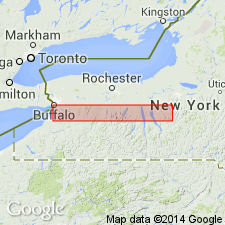
- Usage in publication:
-
- Pond Brook interval
- Modifications:
-
- Named
- Dominant lithology:
-
- Shale
- AAPG geologic province:
-
- Appalachian basin
Summary:
Ledyard Member of Ludlowville Formation subdivided into newly named Winspear and Elma submembers. Pond Brook interval, named for tributary of Buffalo Creek, occurs within the Elma and overlies the Bullis trilobite bed (new). The Pond Brook faunal interval ranges from 1 to 3.5 m in thickness. Contains numerous brachiopods and mollusks within a dark gray shale than contains concretionary bands and limy layers. Juvenile TRUNCALOSIA and TROPIDOLEPTUS and the most characteristic forms. The limy beds and concretionary zones near the top of the Pond Brook are the Mt. Vernon beds of Kloc (1983: SUNY MS thesis). Age is Middle Devonian.
["Submember" not recognized as a formal stratigraphic rank term (CSN, 1933; ACSN, 1961, 1970; NACSN, 1983, 2005). Considered informal until formally published. The rank or lithologic term should not be capitalized.]
Source: GNU records (USGS DDS-6; Reston GNULEX).
For more information, please contact Nancy Stamm, Geologic Names Committee Secretary.
Asterisk (*) indicates published by U.S. Geological Survey authors.
"No current usage" (†) implies that a name has been abandoned or has fallen into disuse. Former usage and, if known, replacement name given in parentheses ( ).
Slash (/) indicates name conflicts with nomenclatural guidelines (CSN, 1933; ACSN, 1961, 1970; NACSN, 1983, 2005, 2021). May be explained within brackets ([ ]).

